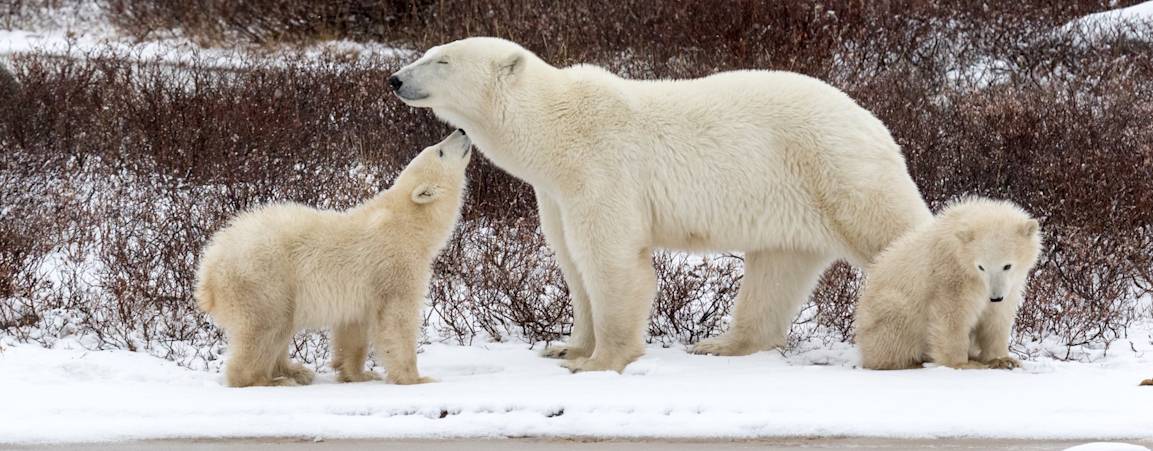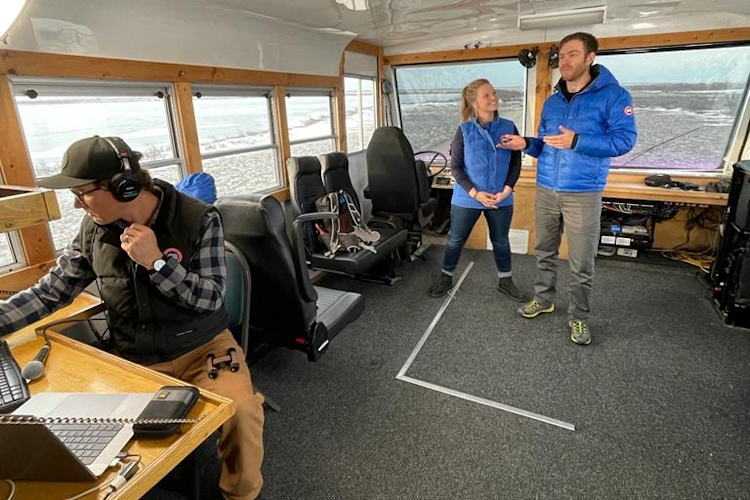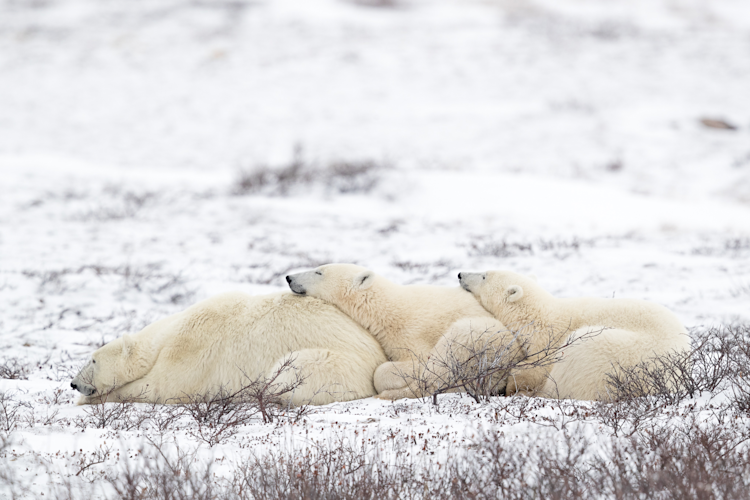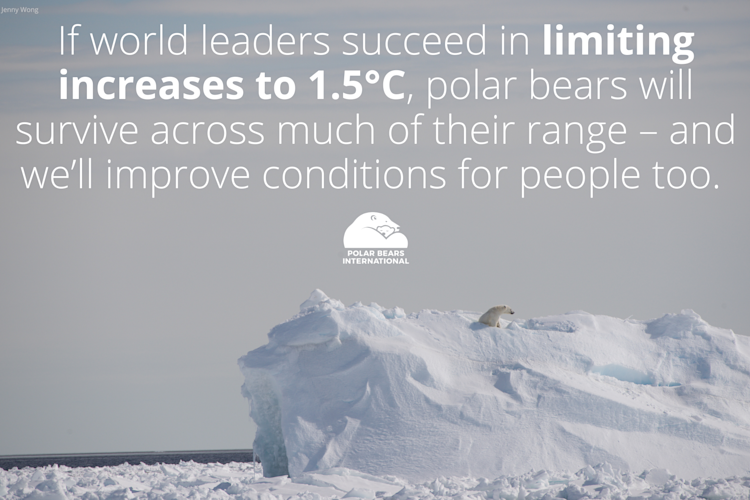Photo: Simon Gee / Polar Bears International

Polar Bear Week AAC Toolkit
Polar Bear Week is the first week of November!
The theme this year is polar bear-human coexistence.
This year the dates are October 27-November 2. You can help by joining our efforts to celebrate the bears and raise awareness about the challenges they face in a warming Arctic, using the tools and resources below.
Why Does it Matter?
We all have a shared desire to keep our communities safe and our traditions intact.
We believe it is important to protect Arctic sea ice, an ecosystem many species depend on across the circumpolar North.
In some regions, polar bears are now spending 3-4 weeks longer on land than their ancestors did, which means less food. Polar Bears rely on the frozen ocean as a platform for hunting, breeding, and in some cases, denning.
When we burn fossil fuels for energy we release carbon dioxide into the atmosphere, which acts like a blanket trapping heat around our planet that would have otherwise escaped, disrupting our climate and melting Arctic sea ice that polar bears and people depend on.
As bears spend more time on land, they’re nutritionally stressed and increasingly sharing space with humans, which raises the risk of human-bear interactions.
Polar Bears International’s Arctic Ambassador Center Network has been inspiring communities to act and making a real impact on wild polar bears for 20 years! As a member of that network, you have an opportunity to talk about climate warming and its impacts on polar bear populations consistently and to change the conversation to be positive, civic-minded, and solutions-focused.
Polar Bear Week in a Nutshell
Every fall, polar bears gather on the shores of Hudson Bay near Churchill, Canada, to wait for the sea ice to return so they can hunt their seal prey. But the summer ice-free period is three to four weeks longer than it was in the 1980s, straining the limits of the bears’ fat reserves.
Polar Bears International founded Polar Bear Week to coincide with the time when the bears have congregated near Churchill, waiting to return to their seal-hunting grounds. During Polar Bear Week, we celebrate the bears and draw attention to the need to take action on climate change … and you can help!
Arctic Ambassador Center materials!
Share your pride in being part of the Arctic Ambassador Center Network by using one of these badges and revisit your 20 year AAC Network Anniversary Toolkit for other assets and talking points.

Photo: Kt Miller / Polar Bears International
Tundra Connections
View our educational webcasts and casual live chats and share the schedule with your membership and educational partners.


Create Your Own Content
As trusted messengers we invite you to be a part of a collective effort to keep polar bears and people safe! Helping polar bears and people coexist with each other while we work to address climate change is a critical part of our work on behalf of polar bears.
Write up your own post or use some of the sample language below!
Key Links & Polar Bears International Handles
Facebook: @PolarBearsInternational
Instagram: @polarbearsinternational
Twitter: @PolarBears
TikTok: @polarbearsinternational
Polar Bear Week short link for social media: pbears.org/polarbearweek
Polar Bear Week Donate short link for social media: pbears.org/protectpbearspeople
Hashtags
#PolarBearWeek #SaveOurSeaIce
Sample Posts
Kindly tag Polar Bears International so we can see your efforts to protect polar bears and people!

Photo: Dmytro Cherkasov
Learn More and Share
Visit our Education Center to view one of our newest units and share with your educational partners.


Climate Action Talking Points
Want to share how important climate action is to you? Visit our new Take Action space on our website and use these talking points to share your concern with those you love and your civic leaders. Also this year, the COP29 Climate Summit is November 11-22, shortly after Polar Bear Week.
Visit our new Take Action Page
Learn more about what you can do to ensure a safe future for polar bears, and people.Call for bold action from #COP29. Ask world leaders to protect people and nature by urgently scaling up climate solutions. Watch for our social media outreach from the Climate Summit in Egypt and join the conversation! This Toolkit, made for educators, is a helpful tool to prepare yourself and your followers to follow COP29 or learn more about international climate negotiations.
Support an #EnergyShift and #VoteForPolarBears. We are so much more than our individual actions. Think about where your strengths and skills can be applied to influencing decisions on where our energy comes from. Research renewable energy options available to you, contact your local and national civic leaders, find a community of others who share your concern for climate change, and invite your friends and family to do the same.
TALK about climate change and solutions. Share these with your viewership and your friends and family. Include them in your distance learning programs or tabling events on grounds. And pull from the youth solutions handout when talking to younger learners.
Hashtags
#SaveOurSeaIce #ClimateActionNow #EnergyShift #COP29
Sample Posts
Feel free to share these sample posts on social media with your own visuals or with one of our included graphics to spread the word. Kindly tag @PolarBearsInternational and/or share a link to our website. We deeply appreciate your support!
Learn more about our coexistence efforts
Across the Arctic, melting sea ice from climate change is driving more polar bears ashore in more places—and for longer periods. This is leading to an uptick in encounters with people, encounters that too often end in tragedy.
To keep people and polar bears safe, communities need reliable techniques to minimize attracting bears and to deter or frighten them away from areas of human activity. Your generosity will help fund a range of coexistence projects.
These include:
Producing safety materials - From easy-to-follow posters to coloring books tailored to the unique situations in different communities, these outreach tools share best practices on staying safe and avoiding conflict.
Consulting with communities - These visits help front-line communities reduce bear attractants and identify the deterrence tools and approaches that work best for them.
Conducting research - This work ranges from testing ground-based radar to detect approaching bears to funding waste management studies and researching the best tools to deter polar bears.
Becoming "Bear Smart" - By supporting the efforts of the town of Churchill to become the world’s first “Bear Smart Community,” we're helping to develop a template that could serve as a model for other northern communities.

Photo: Tim Auer / Polar Bears International
Polar Bears in Your Inbox
Get the inside scoop! Become part of a community dedicated to protecting polar bears by signing up for our free e-news, with content tailored to your interests.

Photo: BJ Kirschhoffer / Polar Bears International
AAC Toolbox
Looking for more? You can always find additional resources in your AAC toolbox.





















